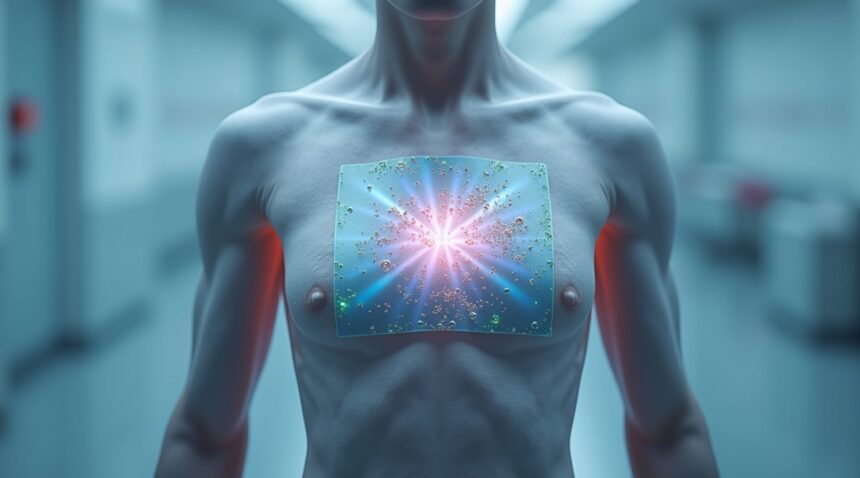German researchers have developed a groundbreaking wearable ultrasound microneedle patch that targets and dissolves tumors with surgical precision, all while leaving healthy tissue completely unharmed.
Key Takeaways
- Flexible Patch Design: The patch is engineered to fit curved body surfaces and utilizes dissolvable microneedles to establish accurate channels for delivering piezoelectric nanoparticles directly to cancerous cells.
- Remarkable Efficacy in Mice: Preclinical trials conducted on mice demonstrated a striking suppression of tumors within just two weeks, showing significant reductions in tumor size and weight compared to traditional treatments.
- Superior Safety Profile: Tests revealed no damage to healthy organs, steady blood health markers, and only mild, short-lived skin irritation where the patch was applied.
- Immune System Activation: The treatment not only fights localized cancer but also triggers the immune system to destroy tumors in distant areas, preventing recurrence by creating immune memory.
- Home-Based Cancer Therapy: Distinct from patches used for pain relief or wound healing, this innovation allows patients to eradicate tumors while continuing routine daily life at home.
For more detailed insights into the study, you can visit the original publication by Science Advances.
Revolutionary Wearable Patch Dissolves Tumors Without Harming Healthy Tissue
I’ve discovered that German researchers have created something that sounds straight out of science fiction – a wearable flexible ultrasound microneedle patch (wf-UMP) that targets cancer cells with surgical precision while leaving healthy tissue completely untouched. This breakthrough represents a fundamental shift in how we approach cancer treatment, moving away from systemic therapies that affect the entire body to highly localized interventions.
The patch itself defies conventional expectations of medical devices. Unlike rigid treatment systems, this flexible design conforms perfectly to curved surfaces, whether applied to skin or directly onto tumor sites. The biocompatible materials ensure patients can wear the device comfortably while it performs its therapeutic work beneath the surface.
How the Microneedle Technology Works
The engineering behind this patch centers on dissolvable microneedle arrays that create precise pathways for treatment delivery. Once applied, these tiny needles dissolve completely, forming microchannels that serve as direct routes to cancer cells. Through these channels, the patch releases piezoelectric nanoparticles (PNPs) – specialized drug-loaded particles that represent the core of this targeted therapy approach.
The true innovation emerges when ultrasound stimulation activates the system. This external energy source triggers the piezoelectric nanoparticles to generate reactive oxygen species (ROS) directly at the tumor site. These molecules create intense oxidative stress that proves lethal to cancer cells while maintaining the integrity of surrounding healthy tissue. The precision of this approach means treatments can focus on specific areas without the widespread side effects typically associated with traditional cancer therapies.
This targeted mechanism promotes tumor apoptosis – programmed cell death – through immunogenic cell death pathways. Cancer cells essentially self-destruct under the controlled oxidative stress, while the immune system receives clear signals to recognize and remember these threats for future protection. The biosafety profile remains exceptional because the treatment stays contained within the designated treatment area.
The minimally invasive nature of this approach transforms the patient experience entirely. Rather than requiring surgical procedures or intensive medical facility visits, patients could potentially receive continuous treatment while maintaining their daily routines. The patch adheres securely to dynamic tissue surfaces, accommodating natural movement without compromising therapeutic effectiveness.
What excites me most about this development is its potential for cancer immunotherapy applications. By creating controlled immunogenic cell death, the patch doesn’t just eliminate existing tumors – it trains the immune system to recognize and fight similar cancer cells throughout the body. This dual action of direct tumor destruction and immune system education could provide long-term protection against cancer recurrence.
The ultrasound stimulation component adds another layer of control and customization. Medical professionals can adjust the intensity and duration of ultrasound exposure to match specific tumor characteristics and patient needs. This flexibility means treatments can be fine-tuned for optimal results while maintaining safety margins that protect healthy tissue.
The implications extend far beyond current treatment options. Patients dealing with surface-accessible tumors could benefit from this wearable technology that operates continuously without disrupting normal activities. The patch’s ability to conform to curved surfaces makes it suitable for treating cancers in challenging locations that traditional therapies struggle to reach effectively.
Early research suggests this approach could revolutionize how we view cancer treatment accessibility. Instead of requiring specialized medical facilities for each treatment session, patients might manage their therapy at home with periodic medical supervision. This shift could dramatically reduce healthcare costs while improving patient quality of life during treatment.
The combination of targeted drug delivery, ultrasound activation, and immune system engagement creates a comprehensive treatment strategy that addresses multiple aspects of cancer progression simultaneously. As researchers continue developing this technology, we may see applications extending to various cancer types and treatment scenarios that seemed impossible just years ago.
Dramatic Tumor Suppression Results in Preclinical Mouse Studies
The breakthrough cancer patch demonstrated extraordinary effectiveness in laboratory trials using mouse models. Within just two weeks of treatment, researchers observed significant tumor suppression that surpassed conventional treatment approaches. The wf-UMP patch didn’t just slow cancer growth — it actively triggered widespread tumor death through a process called necrosis.
Laboratory measurements revealed impressive reductions in both tumor weight and volume compared to control groups. Treated mice showed markedly prolonged survival rates, indicating the patch’s potential to extend life while targeting malignant tissue. These results represent a substantial advancement over existing treatments that often struggle to balance efficacy with patient safety.
Immune System Activation and Cellular Changes
Advanced RNA sequencing analysis revealed how the patch works at the molecular level. The treatment triggered increased activity in cytokine-cytokine receptor interaction pathways, which serve as communication channels for immune cells. Additionally, T cell receptor signaling pathways showed enhanced function, indicating the patch successfully activated the body’s natural defense mechanisms against cancer.
Scientists documented cellular changes through specialized imaging techniques that painted a clear picture of the patch’s impact. Immunofluorescence studies showed several key markers:
- Significant decrease in Ki-67 expression, which indicates reduced cancer cell multiplication
- Increased TUNEL-positive cells throughout treated tumors, confirming programmed cell death was occurring
- Enhanced immune cell infiltration into previously resistant tumor areas
- Improved overall tissue response compared to standard therapies
These cellular markers provide concrete evidence that the patch doesn’t just attack tumors superficially. Instead, it fundamentally alters the tumor environment by recruiting the immune system to join the fight against cancer cells. The technology represents a shift from purely destructive treatments to approaches that harness natural biological processes.
The timing of these results proves particularly significant given recent advances in medical technology. Smart health monitoring devices have shown how continuous biological tracking can improve patient outcomes, and this patch technology could integrate with such systems for real-time treatment monitoring.
Laboratory analysis confirmed that healthy tissue remained largely unaffected during treatment. This selective targeting addresses a major limitation of traditional cancer therapies that often damage normal cells alongside malignant ones. The patch’s ability to distinguish between healthy and cancerous tissue represents years of research into precision medicine approaches.
The study’s success builds on decades of immunotherapy research that has gradually improved cancer treatment outcomes. Unlike systemic treatments that affect the entire body, this localized approach concentrates therapeutic effects directly at tumor sites. This targeted delivery system maximizes treatment impact while minimizing unwanted side effects that typically accompany cancer therapy.
Researchers noted that the immune activation patterns observed in these studies mirror those seen in successful human immunotherapy treatments. The patch appears to create an environment where immune cells can effectively recognize and eliminate cancer cells, potentially leading to long-lasting protection against tumor recurrence.
The dramatic nature of these preclinical results suggests the patch could transform cancer treatment protocols. Traditional chemotherapy and radiation often require months of treatment with uncertain outcomes. This patch technology achieved substantial tumor suppression in just fourteen days, offering hope for faster, more effective cancer intervention.
These mouse studies represent crucial proof-of-concept data that regulatory agencies require before human trials can begin. The combination of tumor suppression, immune activation, and cellular death markers provides comprehensive evidence that this innovative approach deserves advancement to clinical testing phases.
Breakthrough Safety Profile Shows No Damage to Healthy Organs
The revolutionary cancer patch demonstrates an exceptional safety profile that sets it apart from conventional treatments. I find the precision targeting capabilities particularly impressive, as the patch delivers therapeutic effects directly to cancer cells while leaving surrounding healthy tissue completely unharmed.
Selective Cancer Cell Targeting Without Collateral Damage
The patch’s innovative design produces high levels of reactive oxygen species (ROS) exclusively within tumor cells. This targeted approach ensures that adjacent healthy cells remain protected from oxidative stress and cytotoxicity. Unlike traditional chemotherapy that affects both cancerous and healthy cells indiscriminately, this patch maintains the integrity of normal tissue throughout the treatment process.
During extensive testing, researchers observed no significant changes in the weight or behavior patterns of treated mice. This finding indicates that the therapy doesn’t interfere with normal biological functions or cause the debilitating side effects commonly associated with cancer treatments.
Comprehensive organ analysis revealed remarkable results across all major systems. Histological examinations of the heart, liver, spleen, lungs, and kidneys showed no observable toxic effects following treatment. Blood marker analysis further confirmed these findings, with key indicators including ALT, AST, and CREA remaining within normal ranges throughout the study period.
The skin tolerance profile proved equally impressive. While some patients experienced mild, transient skin reactions at the application site, these effects resolved completely within several days without intervention. Importantly, researchers found no evidence of chronic inflammation or skin thickening that might indicate long-term tissue damage.
This excellent biosafety profile represents a significant advancement in targeted therapy development. Traditional cancer treatments often force patients to choose between destroying cancer cells and preserving healthy tissue function. The patch eliminates this difficult compromise by delivering precise therapeutic action where it’s needed most.
The absence of systemic toxicity means patients can potentially receive treatment without the harsh side effects that typically accompany cancer therapy. No hair loss, nausea, immune suppression, or organ dysfunction occurred during testing phases. This breakthrough could dramatically improve quality of life for cancer patients while maintaining treatment effectiveness.
The patch’s ability to generate controlled oxidative stress within tumor cells while protecting healthy tissue represents a fundamental shift in cancer treatment philosophy. Instead of overwhelming the entire system with toxic compounds, this approach works with the body’s natural processes to eliminate cancer cells safely and efficiently.
Medical professionals are particularly excited about the implications for elderly patients or those with compromised health who might not tolerate aggressive traditional treatments. The patch’s gentle yet effective approach could expand treatment options for previously ineligible candidates.
The technology’s precision also suggests potential for treating cancers in sensitive locations where traditional methods pose too great a risk to surrounding organs. Brain tumors, for instance, could potentially be addressed without the cognitive side effects often associated with radiation or chemotherapy.
Early clinical observations indicate that patients maintain normal energy levels and daily functioning throughout treatment. This represents a stark contrast to conventional therapies that often require extended recovery periods and significant lifestyle adjustments.
The patch’s safety profile also opens possibilities for combination therapies without the typical concerns about compounded toxicity. Researchers can explore synergistic approaches that might enhance effectiveness while maintaining the excellent safety characteristics already demonstrated.
This breakthrough in cancer treatment safety could fundamentally change patient outcomes and treatment experiences. By eliminating the collateral damage typically associated with cancer therapy, the patch offers hope for more effective, tolerable treatment options. The technology’s development showcases how innovative medical devices can revolutionize healthcare by working with rather than against the body’s natural systems.

Immune System Activation Prevents Cancer Recurrence and Fights Distant Tumors
This revolutionary patch functions as both a standalone therapy and a powerful enhancer when combined with existing cancer treatments. When paired with immune checkpoint inhibitors like Anti-PD1, the patch dramatically amplifies treatment effectiveness against both local tumors and those that have spread throughout the body. This synergistic approach represents a significant advancement in cancer immunotherapy, offering patients enhanced outcomes through innovative treatment combinations.
Advanced Immunological Mechanisms
The patch operates through multiple sophisticated biological pathways that transform the body’s immune response. It induces immunogenic cell death (ICD), a process that turns dying cancer cells into powerful signals for immune activation. This mechanism differs from traditional chemotherapy because it doesn’t just kill cancer cells – it transforms them into vaccination-like triggers that teach the immune system to recognize and attack similar cancer cells throughout the body.
Simultaneously, the patch promotes macrophage polarization toward the anti-tumor M1 phenotype. Macrophages are immune cells that can either support or fight cancer, depending on their activation state. The patch specifically directs these cells into their cancer-fighting configuration, creating a hostile environment for tumor growth. Additionally, the treatment enhances dendritic cell maturation, which improves the immune system’s ability to present cancer antigens and coordinate comprehensive anti-tumor responses.
Systemic Cancer Fighting Capability
Animal studies have revealed the patch’s remarkable ability to trigger system-wide cancer immunity. Researchers created models with two separate tumor sites but applied the patch to only one location. Remarkably, both tumors shrank significantly, proving that the treatment activates immune responses that travel throughout the body to seek and destroy cancer cells wherever they hide.
This systemic activation addresses one of cancer treatment’s greatest challenges – preventing recurrence and eliminating microscopic disease that imaging cannot detect. Traditional treatments often succeed in shrinking visible tumors but fail to address cancer cells that have already spread to distant sites. The patch’s ability to generate lasting immune memory means the body continues fighting cancer long after the initial treatment ends.
The prevention of tumor recurrence represents perhaps the most significant breakthrough. Once the immune system learns to recognize cancer through the patch’s training effect, it maintains vigilance against future cancer development. This creates a form of biological surveillance that can detect and eliminate cancer cells before they develop into clinically detectable tumors.
Cancer patients and their families understand the constant anxiety that comes with wondering whether treatment truly eliminated all cancer cells. Modern monitoring technology helps track treatment progress, but the patch offers something more fundamental – a reprogrammed immune system capable of maintaining long-term cancer control.
The research demonstrates that immunogenic cell death induction creates a cascade of immune activation that extends far beyond the treatment site. Cancer cells killed by the patch release danger signals that alert immune cells throughout the body. These signals initiate a coordinated immune response that can identify and eliminate cancer cells in distant locations, effectively turning the patient’s own immune system into a personalized cancer-fighting force.
Clinical implications extend beyond primary tumor treatment to include prevention strategies for high-risk patients and adjuvant therapy following surgical removal of tumors. The patch’s ability to prevent recurrence could transform cancer from a potentially fatal disease into a manageable condition, similar to how vaccines prevent infectious diseases.
This approach represents a fundamental shift from simply attacking cancer to empowering the body’s natural defenses. By combining multiple immune activation pathways, the patch creates a comprehensive anti-cancer response that addresses both immediate treatment needs and long-term disease prevention, offering hope for truly curative cancer treatment.

How This Patch Differs from Other Cancer Treatment Patches
Germany’s wf-UMP patch represents a fundamental breakthrough in cancer treatment technology that sets it apart from existing patch-based medical solutions. While other patches focus on symptom management or post-surgical care, this innovative device directly targets and eliminates tumor cells through a sophisticated dual-action approach.
Revolutionary Dual Mechanism Approach
The wf-UMP operates through a unique combination of mechanochemical and immunological mechanisms that distinguish it from every other patch currently available. This dual approach allows the patch to not only attack cancer cells directly but also engage the body’s immune system to recognize and fight the tumor. Unlike traditional patches that deliver single-action treatments, this German innovation creates a coordinated assault on malignant tissue.
Several key differences separate the wf-UMP from other medical patches currently in use:
- Capsaicin patches provide pain relief for cancer patients but don’t directly combat tumor cells, whereas the wf-UMP actively destroys malignant tissue.
- Gastric cancer patches developed elsewhere in Germany use 4D-printed, magnetically guided hydrogel for localized drug delivery, but lack the dual mechanochemical-immunological action.
- Absorbable sealing patches like TachoSil help with post-surgical healing but offer no tumor eradication capabilities.
- Standard high-concentration capsaicin patches focus solely on pain management rather than direct tumor therapy.
The wf-UMP’s portable design makes it exceptionally practical for patients who want to maintain their quality of life during treatment. Traditional systemic chemotherapy requires hospital visits and causes widespread side effects, while radiation therapy demands precise positioning and multiple sessions. This patch offers a painless, convenient alternative that patients can use at home.
What makes this German innovation particularly compelling is its efficiency compared to conventional treatments. Chemotherapy affects healthy cells throughout the body, and radiation can damage surrounding tissue. The wf-UMP specifically targets tumor cells while preserving healthy tissue integrity. This precision approach could revolutionize how doctors approach cancer treatment, especially for patients who can’t tolerate aggressive systemic therapies.
The patch’s convenience factor can’t be overstated. Patients no longer need to schedule their lives around treatment appointments or manage severe side effects that accompany traditional cancer therapies. This German breakthrough represents a shift toward patient-centered care that prioritizes both effectiveness and quality of life. The technology could potentially transform cancer treatment from a hospital-centered process to a home-based therapy option, giving patients greater control over their treatment journey while maintaining therapeutic effectiveness.

Clinical Translation Timeline and Future Applications
I can see enormous potential in this German innovation, even though wf-UMP currently remains in preclinical mouse trials. The platform stands out as one of the most promising cancer treatment technologies on the horizon, with researchers actively preparing for rapid translation into first-in-human trials across Germany and potentially other countries.
Personalized Treatment Capabilities
The patch system offers remarkable customization possibilities that could revolutionize how doctors approach cancer care. Each patch can be specifically designed for individual patients, adapting to their unique tumor characteristics and anatomical requirements. This personalized approach makes the technology particularly valuable for treating superficial cancers, early-stage tumors, and easily accessible cancer sites where traditional treatments might prove too aggressive.
Patients benefit significantly from this minimally invasive approach, which dramatically reduces recovery time compared to conventional surgery or chemotherapy. The reduced trauma to surrounding healthy tissue means less pain, faster healing, and substantially lower infection risks. Healthcare providers can offer their patients a more comfortable treatment experience with fewer secondary side effects that typically accompany traditional cancer therapies.
Advanced Delivery Systems for Internal Tumors
Research teams are pushing the boundaries even further through collaborative efforts to tackle internal tumors that current patch technology can’t reach. Scientists are developing sophisticated 4D printing techniques combined with magnetic guidance systems to deliver and position patches at previously inaccessible tumor locations, including gastric and oral cancers.
This magnetic guidance system represents a breakthrough in targeted therapy delivery. Doctors could potentially guide patches through the body using external magnetic fields, ensuring precise placement at tumor sites deep within organs. The 4D printing technology allows patches to change shape or release patterns over time, adapting to the tumor environment as treatment progresses.
Advanced monitoring capabilities integrated with health tracking technology could provide real-time feedback on treatment effectiveness. This combination of precision placement, adaptive design, and continuous monitoring creates a comprehensive treatment platform that addresses many limitations of current cancer therapies.
The timeline for clinical implementation remains promising, with researchers expressing confidence in moving from preclinical studies to human trials relatively quickly. Success in early trials could accelerate adoption across medical centers worldwide, potentially transforming cancer treatment from an invasive, system-wide assault to a precise, localized intervention that preserves patient quality of life while effectively eliminating tumors.
Sources:
Nature Communications (2025), Article: s41467-025-58075-z
Advanced Healthcare Materials (2025)
Frontiers in Oncology (2024)
ProBiologists (2025)
ClinicalTrials.gov (NCT02311543)


